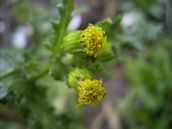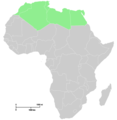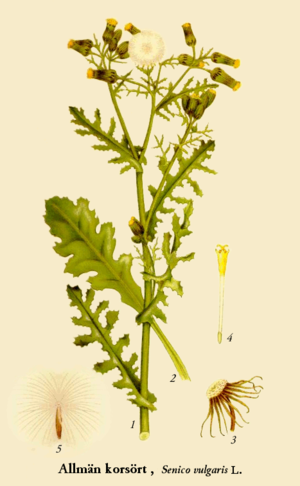القريض، نبات
| القريض، نبات | |
|---|---|
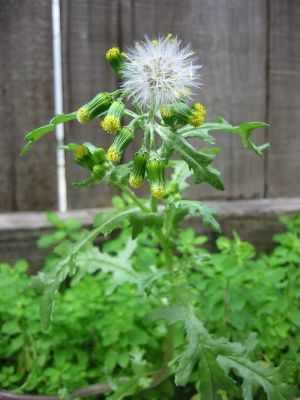
| |
| Common groundsel | |
| التصنيف العلمي | |
| مملكة: | |
| (unranked): | |
| (unranked): | |
| (unranked): | |
| Order: | |
| Family: | |
| Tribe: | |
| Genus: | |
| Species: | S. vulgaris
|
| Binomial name | |
| Senecio vulgaris | |

| |
| Range of Senecio vulgaris | |
| Synonyms | |
|
Senecio dunensis Dumort | |
القريض Senecio vulgaris، هو عشب شائع ينتمي إلى زهرة الربيع (الفصيلة المركبة). ينمو أصلاً في آسيا وأوروبا، ولكنه ينتشر في العديد من مناطق العالم الأخرى.
. . . . . . . . . . . . . . . . . . . . . . . . . . . . . . . . . . . . . . . . . . . . . . . . . . . . . . . . . . . . . . . . . . . . . . . . . . . . . . . . . . . . . . . . . . . . . . . . . . . . . . . . . . . . . . . . . . . . . . . . . . . . . . . . . . . . . . . . . . . . . . . . . . . . . . . . . . . . . . . . . . . . . . . .
الوصف
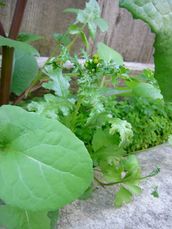
القريض الشائع نبات حَوْليّ صغير ينمو إلى 30سم، وله أوراق خضراء ذات فصوص مسننة بغير انتظام. وفي بعض النباتات تحمل الأوراق شعيراتٍ بيضاء كالقطن، وتنمو أزهار صفراء صغيرة في عناقيد على أطراف سويقات قصيرة. وتنتجُ هذه النباتات ثمارًا بمقادير وافرةٍ. وعندما تنبت البذور تعطي نباتات كاملة جديدة تنمو وتحمل ثمارًا في فترة قصيرة تقل عن خمسة أسابيع. وقد يظهر جيلان أو ثلاثة أجيال من هذه النباتات في موسم واحد. وقد يكون هناك 1000 مليون في نهاية الجيل الثالث، إذا بقيت جميع البادرات التي نمتْ من نبات واحد على قيد الحياة. وبإمكان نباتات القريض الصغيرة أن تحد من نمو نباتات الحدائق المُهملة. تضم فصيلة القريض الشائع نباتات زهرة الشيخ، والقريض العملاق الذي ينمو في الجبال في إفريقيا الاستوائية.
أسماء مشتركة
|
 Senecio vulgaris, taken in فرنسا |
التوزيع
Senecio vulgaris is a frost resistant[12] Wisconsin,[13] Saskatchewan,[14] British Columbia,[15] Missouri.[16]
United States Geological Survey (2006). "Nature Serve Species Profile for Old-man-in-the-spring (Senecio vulgaris)". NatureServe. NatureServe’s Central Databases. Arlington, VA. U.S.A. Retrieved 2008-02-01.</ref>
"Senecio vulgaris L." Primera página de la especie (in Spanish). Malezas de México. Retrieved 2008-01-30.{{cite web}}: CS1 maint: unrecognized language (link)
</ref>[17][18][19][20][21][22][23][24]
- America
- Canada: Alberta, British Columbia, Manitoba, New Brunswick, Newfoundland and Labrador, Northwest Territories and Nunavut (not collected North of the Hudson Bay), Nova Scotia, Ontario, Prince Edward Island, Quebec, Saskatchewan, Yukon.
- Mexico: Aguascalientes, Baja California Norte, Chiapas, Coahuila, Distrito Federal, Hidalgo, Jalisco, Estado de México, Nuevo León, Puebla, Tlaxcala, Veracruz
- North America: United States of America, Greenland, Saint Pierre and Miquelon
- South America: الأرجنتين, Bolivia, Chile, Ecuador, Peru
- Africa
- Asia
- Western Asia: Iran, Israel with the Palestinian territories, Lebanon and Syria.
- Caucasus: Adygea, Azerbaijan, Chechnya, Dagestan, Georgia, Ingushetia, Kabardino-Balkaria, Kalmykia, Karachay-Cherkessia, North Ossetia-Alania
- Northwestern Asia: Arkhangelsk Oblast including Nenets Autonomous Okrug and Novaya Zemlya, Astrakhan Oblast, Bashkortostan, Belgorod Oblast, Bryansk Oblast, Chuvashia, Lipetsk Oblast, Kaliningrad Oblast, Kaluga Oblast, Novgorod Oblast, Republic of Karelia, Kirov Oblast, Komi Republic, Kursk Oblast, Mordovia, Murmansk Oblast, Orenburg Oblast, Penza Oblast, Perm Krai, Pskov Oblast, Rostov Oblast, Ryazan Oblast, Saint Petersburg, Samara Oblast, Saratov Oblast, Tambov Oblast, Tatarstan, Tula Oblast, Udmurtia, Volgograd Oblast, Vologda Oblast, Voronezh Oblast,
- Siberia: Altai Krai, Buryatia, Chelyabinsk Oblast, Chita Oblast, Irkutsk Oblast, Kemerovo Oblast, Krasnoyarsk Krai, parts of Kurgan Oblast, Novosibirsk Oblast, Omsk Oblast, Sverdlovsk Oblast, Tomsk Oblast, Tuva, Tyumen Oblast, Ulyanovsk Oblast, Yamal-Nenets,
- Soviet Far East: Amur Oblast, Chukotka Autonomous Okrug, Jewish Autonomous Oblast, Kamchatka Oblast, Koryak Autonomous Okrug, Khabarovsk Krai, Magadan Oblast, Primorsky Krai, Sakha (Yakutia) Republic, Sakhalin Oblast
- China: Inner Mongolia, Heilongjiang, Jilin, Liaoning, Hebei and Beijing
- Eastern Asia: South Korea, North Korea, Hokkaidō, Honshū, Shikoku, Kyūshū, Okinawa Island
- Europe
- Northern Europe: Channel Islands, Denmark, Estonia, Faeroe Islands, Finland, Iceland, Ireland with Northern Ireland, Norway, Sweden, المملكة المتحدة
- Middle Europe: Austria, Czech Republic, ألمانيا, Poland, Slovakia, Slovenia,
- East Europe: Belarus, Hungary, Latvia, Lithuania, Moldavia, Ukraine
- Southeastern Europe: Bosnia and Herzegovina, Bulgaria, Croatia, Republic of Macedonia, Montenegro, Romania, Serbia
- Southwestern Europe: Andorra, Azores, Balearic Islands, Canary Islands, Gibraltar, Portugal, Spain
- West Europe: Belgium, فرنسا, Liechtenstein, Luxembourg, Netherlands, Switzerland,
- South Europe: Albania, Chios, Corsica, Crete, Cyprus, Dodecanese, Greece, Ikaria, إيطاليا, Karpathos, Lesbos, Samos Island, San Marino, Sardinia, Sicily with Malta, Asiatic Turkey and Turkey-in-Europe, Vatican City
- Oceania
- Australasia: Jarrah Forest, Swan Coastal Plain, Warren, New Zealand
- Range maps for continents
المفترسات

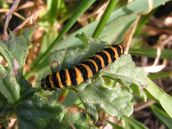
Beetles
- Ragwort flea beetle (Longitarsus jacobaeae)
- Longitarsus gracilis (family Coleoptera species Chrysomelidae)
Flies
- Seed flies (Diptera: Muscoidea)
- Ragwort seed fly (Anthomyiidae, Botanophila seneciella)
- Gall flies (Diptera: Tephritidae):
- Rust fungus Uredinales
- Coleosporium tussilaginis - stems and leaves (Coleosporiaceae)
- Puccinia lagenophorae - leaves only (Pucciniaceae)
- Bremia lactucae
- White rust Peronosporales
- Albugo tragopogonis - (Albuginaceae)
- some of the species Peronosporaceae - (Albuginaceae)
- Sac fungus Ascochyta, Pezizomycetes
- Groundsel Mildew Erysiphales
- Golovinomyces cichoracearum var. fischeri
- Powdery Mildew Erysiphales
- Black root rot Microascales
- some of the family Incertae sedis
and other fungus that are not listed here
الضرر والسمية
Senecio vulgaris has been listed as a noxious weed,[25] being both non-indigenous to most if not all of the Americas and having a reputation for being hepatotoxic to livestock[26] and to humans.[27][28][29]
. . . . . . . . . . . . . . . . . . . . . . . . . . . . . . . . . . . . . . . . . . . . . . . . . . . . . . . . . . . . . . . . . . . . . . . . . . . . . . . . . . . . . . . . . . . . . . . . . . . . . . . . . . . . . . . . . . . . . . . . . . . . . . . . . . . . . . . . . . . . . . . . . . . . . . . . . . . . . . . . . . . . . . . .
Toxic versus medicinal
Human
GreenFacts. "Chronic exposure". GreenFacts Glossary. Retrieved 2008-02-01.</ref> can cause irreversible liver damage.[4][30]
M. Walderhaug, United States Food and Drug Administration (1992). "Bad Bug Book: Pyrrolizidine Alkaloids". Foodborne Pathogenic Microorganisms and Natural Toxins Handbook. FDA/Center for Food Safety & Applied Nutrition. Retrieved 2008-02-05. {{cite web}}: Unknown parameter |month= ignored (help)</ref>[31][32][33]
Manuel Hernandez (2004-02-23). "Pyrrolizidine Alkaloids". Poisonous Plants Homepage. Animal Science at Cornell University. Retrieved 2008-02-05.</ref>
Livestock
Susan Aldrich-Markham, Oregon State University (1994). "Common Groundsel Senecio vulgaris L., PNW 466". Pests in Gardens and Landscapes. Oregon State University Cooperative extension service. Retrieved 2008-02-02. {{cite web}}: Unknown parameter |month= ignored (help)</ref>[34] The alkaloids responsible are not destroyed by drying or by fermentation in silage.[3]
المقدمة مقابل الغازية
"Common Groundsel". Written Findings of the State Noxious Weed Control Board. Washington State's 2004 Noxious Weed list. 2004. Retrieved 2008-02-03.</ref> There is evidence that it is not a strong invasive and sometimes protective of critically endangered native plants.[35]
Control
The approximately 22 millimetres (0.87 in) long[36] pappus seeds of Senecio vulgaris, each plant capable of producing 25,000 or more seeds (1,700 seeds per plant are more likely) with three generations of the plant per year[37]; seeds that are widely dispersed by the wind,[38]
- Biological
J. Frantzen and P. E. Hatcher (2004-11-24). "A fresh view on the control of the annual plant Senecio vulgaris". Integrated Pest Management Reviews. Springer Netherlands. doi:10.1023/A:1018436614685. Retrieved 2008-02-03.</ref> One study showed that rust fungus infected Senecio vulgaris survived and actually used more of the available soil nutrients.[39] The cinnabar moth eats groundsel between June and August, but the seeds germinate and the plant grows as soon as the ground is warm enough (and after a warm rain)[40], making this an insufficient control almost everywhere groundsel can be found.[37]
- Chemical:
Leslie Huffman- Weed Management Specialist (Horticultural Crops)/OMAFRA. "Reducing Common Groundsel in Strawberry Fields". Government of Ontario, Canada. Retrieved 2008-02-03.</ref> carrots[41] and all other non-grass crops. There is also evidence that the plant develops an immunity to the chemical control.[42][43]
- Other: Groundsel seedlings with 2-6 leaves are tolerant of flame weeding but the seeds are susceptible to soil solarization.[12]
السلالات
- Senecio vulgaris subsp. denticulatus (O.F. Muell.) P.D. Sell
- Senecio vulgaris var. dubius (Ledeb.) Franch., 1883
- Senecio vulgaris var. dubius Trautv., 1866
- Senecio vulgaris var. hibernicus Syme
- Senecio vulgaris var. vulgaris[44]
- Senecio vulgaris-humilis Batt. & Trab.[45]
المصادر
- ^ Natural Resources Conservation Service (NRCS). "Plants Profile, Senecio vulgaris L." The Plants Database. United States Department of Agriculture,. Retrieved 2008-01-29.
{{cite web}}: CS1 maint: extra punctuation (link) - ^ Royal Botanic Garden Edinburgh. "Flora Europaea Search Results matching vulgaris and Senecio". Retrieved 2008-02-01.
- ^ أ ب Henry Doubleday Research Association (2007). "Groundsel". Organic Weed Management. Garden Organic. Retrieved 2008-02-05.
{{cite web}}: Unknown parameter|month=ignored (help) - ^ أ ب M. Grieve (1931). "Groundsel, Common". A Modern Herbal. © Copyright Protected 1995-2008 Botanical.com. Retrieved 2008-02-02.
- ^ أ ب Germplasm Resources Information Network (GRIN) (2007-05-04). "Taxon: Senecio vulgaris L." Taxonomy for Plants. USDA, ARS, National Genetic Resources Program, National Germplasm Resources Laboratory, Beltsville, Maryland. Retrieved 2008-01-27.
- ^ California Department of Food and Agriculture. "Senecio genus". Encycloweedia. State of California. Retrieved 2008-01-31.
- ^ Dr. Alice B. Russell, Department of Horticultural Science, North Carolina State University (1997). "Poisonous Plants: Senecio spp". Poisonous Plants of North Carolina. Retrieved 2008-02-02.
{{cite web}}: CS1 maint: multiple names: authors list (link) - ^ Peterson Field Guide, Theodore F. Niehaus (1976) [1976]. Pacific States Wildflowers. The Peterson Field Guide Series. Illustrations by Charles L. Ripper. New York, New York 100003: Houghton Mifflin Company. p. 208. ISBN 0-395-91095-1 begin_of_the_skype_highlighting 0-395-91095-1 end_of_the_skype_highlighting.
{{cite book}}:|access-date=requires|url=(help); Check|isbn=value: invalid character (help); no-break space character in|isbn=at position 46 (help)CS1 maint: location (link) - ^ Botanic Garden and Botanical Museum Berlin-Dahlem. "Details for: Senecio vulgaris". Euro+Med PlantBase. Freie Universität Berlin. Retrieved 2008-01-27.
- ^ Flora of North America. "Chinese Plant Names Senecio vulgaris L." Chinese Plant Names. Retrieved 2008-02-01.
- ^ "ノボロギク" (in Japanese). Retrieved 2008-02-03.
{{cite web}}: CS1 maint: unrecognized language (link) - ^ أ ب Hedgerowmobile. "Groundsel (Senecio vulgaris)". Species lists. Hedgerows, Hedges and Verges of Britain and Ireland. Retrieved 2008-02-05.
Natural Resources Conservation Service (NRCS). "The Plants Database". United States Department of Agriculture,. Retrieved 2008-02-01.
{{cite web}}: CS1 maint: extra punctuation (link) Germplasm Resources Information Network (GRIN) (2007-10-29). "National Plant Germplasm System". Germplasm Resources Information Network. USDA, ARS, National Genetic Resources Program, National Germplasm Resources Laboratory, Beltsville, Maryland. Retrieved 2008-02-01. {cite web | url = http://www.itis.gov/organ.html | title = About ITIS | accessdate = 2008-02-01 | authorlink = Integrated Taxonomic Information System | author =Integrated Taxonomic Information System Organization (ITIS) | date = 2002-09-09 | work = Integrated Taxonomic Information System on-line database }} Integrated Taxonomic Information System Organization (ITIS) (2007-12-20). "Senecio vulgaris". Integrated Taxonomic Information System on-line database. Retrieved 2008-01-29. Flora of North America. "37. Senecio vulgaris Linnaeus". pp. Vol. 20 Page 548, 562, 563. Retrieved 2008-02-01. Richard Wunderlin or Bruce Hansen (2006). "Senecio vulgaris L." Atlas of Florida Vascular Plants. Institute for Systematic Botany. Retrieved 2008-02-01.{{cite web}}: External link in|work= - ^ University of Wisconsin–Stevens Point. "Senecio vulgaris L." Robert W. Freckmann Herbarium. Retrieved 2008-02-01.
- ^ Government of Saskatchewan (2007). "Common Groundsel". Weed Identification Guide. Retrieved 2008-02-01.
- ^ Center for Biological Informatics of the U.S. Geological Survey. "Weeds of British Columbia Listed by Common Name". Retrieved 2008-02-01.
- ^ Flora of North America. "Flora of Missouri Senecio vulgaris Linnaeus". Retrieved 2008-02-01.
- ^ Global Biodiversity Information Facility. "Species: Senecio vulgaris L. Common Groundsel". Species Data. GBIF Data Portal. Retrieved 2008-02-08.
- ^ "Japanese Wild Flowers Senecio vulgaris". Prof. Summer's Web Garden. 2007-12-31. Retrieved 2008-02-03.
- ^ European crop wild relative diversity assessment and conservation forum (2005). "PGR Forum Crop Wild Relative Catalogue for Europe and the Mediterranean Senecio vulgaris". CWR Case Studies. Crop Wild Relative Information System. Retrieved 2008-02-05.
- ^ Helen Coleman, FloraBase: Flora of Western Australia (1997-06-18). "Senecio vulgaris L." Flora Descriptions. Government of Western Australia. Retrieved 2008-02-03.
- ^ Andrew J. Lowe and Richard J. Abbott (1998-10-30). "Routes of origin of two recently evolved hybrid taxa: Senecio vulgaris var. hibernicus and York radiate groundsel (Asteraceae)". American Journal of Botany. Botanical Society of America. pp. 2000, 87:1159–1167. Retrieved 2008-02-03.
- ^ Instituto Darwinion. "Asteraceae" (PDF). Catálogo de las Plantas Vasculares de la República Argentina. II (in (بالإسپانية)). Universidad de Buenos Aires. p. 255. Retrieved 2008-03-05.
{{cite web}}: CS1 maint: unrecognized language (link) - ^ Flora of Chile. "Volume 4 Asteraceae Senecio L." 4. Retrieved 2008-03-06.
{{cite journal}}: Cite journal requires|journal=(help) - ^ Flora of Israel Online. "Senecio vulgaris L." Hebrew University of Jerusalem. Retrieved 2008-03-06.
- ^ Natural Resources Conservation Service (NRCS). "Washington State-listed Noxious Weeds". Invasive and Noxious Weeds. United States Department of Agriculture,. Retrieved 2008-02-01.
{{cite web}}: CS1 maint: extra punctuation (link) - ^ C. A. Wilen, University of California, Integrated Pest Management Program, San Diego County (2006-05-23). "Common Groundsel IMPACT". Pests in Gardens and Landscapes; Common Groundsel Management Guidelines. Statewide IPM Program, Agriculture and Natural Resources, University of California. Retrieved 2008-02-01.
{{cite web}}: CS1 maint: multiple names: authors list (link) - ^ Dr A. Furtado Rahde (1989). "Senecio Vulgaris L. (PIM 484)". Chemical Safety Information from Intergovernmental Organizations. International Programme on Chemical Safety. Retrieved 2008-02-05.
{{cite web}}: Unknown parameter|month=ignored (help) - ^ Ministry of Agriculture and Lands. "Common Groundsel Senecio Vulgaris". Weeds BC. Government of British Columbia. Retrieved 2008-02-01.
- ^ Cornell Poisonous Plants Database (2008-01-16). "Cornell University answers questions about California Bay Area plants". Retrieved 2008-02-01.
- ^ Government of Canada (2006-05-30). "Notes on poisoning: Senecio vulgaris". Canadian poisonous plants. Canadian Biodiversity Information Facility. Retrieved 2008-02-02.
- ^ Subhuti Dharmananda, Ph.D. "Safety issues affecting herbs: pyrrolizidine alkaloids". Institute for Traditional Medicine, Portland, Oregon. Retrieved 2008-02-05.
- ^ Prakash AS, Pereira TN, Reilly PE, Seawright AA. (1999-07-15). "Pyrrolizidine alkaloids in human diet". National Center for Biotechnology Information, University of Queensland. Retrieved 2008-02-05.
{{cite web}}: CS1 maint: multiple names: authors list (link) - ^ Manitoba Agriculture, Food and Rural Initiatives (MAFRI) (2006). "Common Groundsel - Weeds - Manitoba Agriculture, Food and Rural Initiatives". Manitoba Agriculture, Food and Rural Initiatives (MAFRI) and Manitoba Agricultural Services Corporation. Retrieved 2008-02-01.
{{cite web}}: External link in|publisher=|month=ignored (help) - ^ Jennifer M. Duringer, Donald R. Buhler, A. Morrie Craig (2004). "Comparison of hepatic in vitro metabolism of the pyrrolizidine alkaloid senecionine in sheep and cattle". American Journal of Veterinary Research. American Veterinary Medical Association. pp. Vol. 65, No. 11, Pages 1563–1572. doi:10.2460/ajvr.2004.65.1563. Retrieved 2008-02-05.
{{cite web}}: Unknown parameter|month=ignored (help)CS1 maint: multiple names: authors list (link) - ^ U.S. Fish and Wildlife Service (2002-06-19). "Endangered and Threatened Wildlife and Plants; Critical Habitat Designation for Sidalcea keckii (Keck's checkermallow)". Federal Register Online via GPO Access. United States Department of the Interior. pp. RIN 1018-AG93, Page 41669–41683. Retrieved 2008-02-03.
- ^ Department of Horticulture and Crop Science, Ohio State University. "Senecio vulgaris". Seed ID Workshop. Ohio State University Cooperative extension service. Retrieved 2008-02-01.
- ^ أ ب خطأ استشهاد: وسم
<ref>غير صحيح؛ لا نص تم توفيره للمراجع المسماةOSUES - ^ "Seed Exchange". A public access seed bank - established 1911. J. L. Hudson, Seedsman. 2008-01-31. Retrieved 2008-02-05.
- ^ N. D. Paul and P. G. Ayres (1987-11-09). "Nutrient Relations of Groundsel (Senecio vulgaris) Infected by Rust (Puccinia lagenophorae) at a Range of Nutrient Concentrations II. Uptake of N, P and K and Shoot-Root Interactions". Annals of Botany Company. pp. 61: 499–506, 1988. Retrieved 2008-02-03.
- ^ خطأ استشهاد: وسم
<ref>غير صحيح؛ لا نص تم توفيره للمراجع المسماةBioone-emergence1 - ^ EWRS Working Group "Weed Management Systems in Vegetables", University of Perugia. carrots.htm "Weeds and weed management in carrots - a review". 11th EWRS (European Weed Research Society) Symposium 1999, Basel. Facoltà di Agraria - Università degli Studi di Perugia. Retrieved 2008-02-03.
{{cite web}}: Check|url=value (help) - ^ William B. McCloskey and Jodie S. Holt (1990). "Triazine Resistance in Senecio vulgaris Parental and Nearly Isonuclear Backcrossed Biotypes Is Correlated with Reduced Productivity". Plant Physiology. American Society of Plant Biologists. pp. Vol. 92(4): pp. 954–962. Retrieved 2008-02-01.
Isonuclear triazine-susceptible and triazine-resistant Senecio vulgaris L. biotypes were developed by making reciprocal crosses between susceptible and resistant biotypes....
{{cite web}}: Unknown parameter|coauthors=ignored (|author=suggested) (help); Unknown parameter|month=ignored (help) - ^ Michel Havaux, Society for Experimental Biology, 2005 (1989). "Comparison of Atrazine-Resistant and -Susceptible Biotypes of Senecio vulgaris L.: Effects of High and Low Temperatures on the in vivo Photosynthetic Electron Transfer in Intact Leaves". Journal of Experimental Botany. Oxford University Press. pp. Volume 40, Number 8, Pp. 849–854. Retrieved 2008-02-01.
The effects of temperature on the yield of in vivo modulated chlorophyll fluorescence were measured in intact leaves of atrazineresistant and -susceptible biotypes of the weed Senecio vulgaris L. ....
{{cite web}}: CS1 maint: multiple names: authors list (link) CS1 maint: numeric names: authors list (link) - ^ Missouri Botanical Garden. "Tropicos Web display Senecio vulgaris L." Nomenclatural and Specimen Data Base. Missouri State Library. Retrieved 2008-02-01.
- ^ African Flowering Plants Database. "Senecio vulgaris L." South African National Biodiversity Institute. Retrieved 2008-02-16.
{{cite web}}: External link in|publisher=
وصلات خارجية
|
|
. . . . . . . . . . . . . . . . . . . . . . . . . . . . . . . . . . . . . . . . . . . . . . . . . . . . . . . . . . . . . . . . . . . . . . . . . . . . . . . . . . . . . . . . . . . . . . . . . . . . . . . . . . . . . . . . . . . . . . . . . . . . . . . . . . . . . . . . . . . . . . . . . . . . . . . . . . . . . . . . . . . . . . . .
قراءات أخرى
|
- CS1 errors: unsupported parameter
- CS1 errors: invisible characters
- CS1 errors: ISBN
- CS1 errors: access-date without URL
- CS1 maint: location
- CS1 errors: URL
- CS1 maint: numeric names: authors list
- Articles containing إنگليزية-language text
- Pages using Lang-xx templates
- Articles containing برتغالية-language text
- Articles containing نرويجية-language text
- Articles containing دنماركية-language text
- Articles containing كرواتية-language text
- Articles containing ألمانية-language text
- Lang and lang-xx template errors
- Articles containing مالطية-language text
- Articles containing فرنسية-language text
- Articles containing قطلان-language text
- Articles containing هولندية-language text
- Articles containing سويدية-language text
- Articles containing آيسلندية-language text
- Articles containing Slovene-language text
- Articles containing لتوانية-language text
- Articles containing فنلندية-language text
- Articles containing پولندية-language text
- Articles containing إيطالية-language text
- Articles containing إسپانية-language text
- Articles containing سلوڤاكية-language text
- Articles containing عبرية-language text
- Articles containing روسية-language text
- Articles containing Chinese-language text
- CS1 errors: markup
- Senecio

